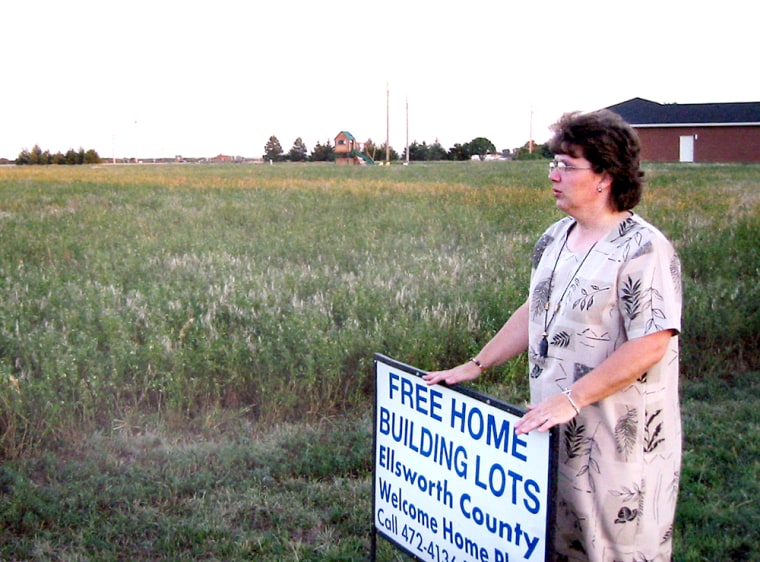Here in the heartland, the prairie homesteading tradition lives again.
Land — that coveted, crowded, pricey possession in America’s hot spots — can be had these days for nothing in a growing number of Great Plains communities.
Sagging populations prompted economic planners to offer juicy incentives inspired by the land giveaways to settlers in the mid-to late 1800s. And so, in the middle of Kansas, Maribel Juarez has rediscovered the town of her El Salvadoran childhood.
In Ellsworth, just as in El Salvador’s Atiquizaya in the old days, church bells chime. Freight trains clatter and whistle day and night. Everyone knows everyone else — and their business — and there’s no fighting with traffic.
“I found a place exactly like my hometown and it’s in America,” Juarez says with a broad smile. “To us, this is our promised land. We don’t need anything else.”
Lured by an offer of free property, Juarez, 44, and her husband, Madecadel, 46, came to Kansas from Vallejo, Calif., two months ago. They went from an apartment where they feared letting their daughter out on her bicycle to a nearly new home with a big lawn, oak floors and a sense of utter safety.
More than a dozen communities in Kansas and Nebraska are giving away land or planning to do so as a way to staunch population declines and boost local economies.
Ellsworth’s giveaway has had an impact, but not the one its creators expected. Anita Hoffhines, the economic development director who is the spark of the program, pictured newcomers snapping up the free lots and building their dream homes.
Instead, all the outsiders who have come to size up the properties, in many cases reserving them, ended up buying existing homes they saw when they tooled around town. So far, 18 families in two years have settled here that way and taken advantage of the second big incentive Ellsworth County offers — a down-payment grant of up to $3,000 for families with children.
The county gets a tangible benefit from its investment, beyond the boost of having more people around to shop. Each child who enters a local school attracts $6,000 a year in state aid. The 25 kids who have enrolled from the new families bring $150,000 annually to the education system, enough to pay for several teachers.
One-stoplight town
Hoffhines is the first to say places like Ellsworth are not for everyone. The one grocery store has a modest selection and uncompetitive prices. Fancy clothes are not to be found. “I drive 40 miles to get fresh salmon,” she said. “If I want sushi, I’m not going to find it here.”
One of the most common questions she gets from prospective settlers is where the nearest Wal-Mart is located. “Some people are just addicted to Wal-Mart,” she said. They drive 50 minutes to Salina to get their fix, or make do with mail order or Internet shopping.
Apart from the Pizza Hut and Dairy Queen, this one-stoplight town is untouched by the big shopping and restaurant chains. People can choose between two dentists, two law firms and two old-time independent drug stores across the main street from each other. Stores close early, and there’s nothing much happening on a Sunday.
On the other hand, Ellsworth offers some brick streets, a cappuccino bar in one of the antique stores, a nine-hole golf course, recreation center, a new medical center, a 24-hour gas station and convenience store, and an outdoor swimming pool with a slide.
The county treasurer’s office, which used to close for lunch, stays open now, thanks to a campaign pledge by the previous occupant of the office to end the noon break. In fact, life in general here “is pretty much in the open,” says Hoffhines.
“You can’t hide,” she said. “If you come to give to the community, you will be received. If you come to take, you won’t.”
The town now has 10 free lots available, each about one-third of an acre, and four more elsewhere in the county. Local families are eligible for the free lots, and two have built on them, but the down-payment aid is for newcomers only.
Strings attached
Amy Eck, 31, came from Phillipsburg 130 miles away to take a job as managing editor of the local weekly, the Ellsworth County Independent. She and her husband realized it would take too long to build a new home on a free lot and it would be an iffy investment anyway.
“It just wasn’t worth it,” she said. But her son qualified the family for the down-payment grant, and she liked the community. “When I send my son to school, he doesn’t have to enter a metal detector.”
Families get $1,500 for the first child and $750 each for others, to a $3,000 maximum.
Ellsworth’s land program comes with strings to discourage indigents and substandard housing. Applicants must qualify for a mortgage, build a house of at least 1,000 square feet, pour a foundation, have a building contract within six months, break ground in a year, move in within two years and meet other conditions.
That program brought the Juarezes to Kansas, but it was the place that ultimately sold them.
Madecadel Juarez, a hotel maintenance worker in California, lucked into a job in Ellsworth as a civil engineer, the profession he’d trained for before coming to the United States. He works a mile away and comes home for lunch, which he couldn’t do in Vallejo.
In a few months, the family switched from a city of 120,000 people to one of fewer than 3,000.
Hispanics make up 16 percent of Vallejo’s population, less than 4 percent of Ellsworth’s.
But Maribel felt no culture shock.
“So peaceful,” she said. “We just feel at home.”
